Innovation Strategies Report: Analysis of Expanding Door Innovation
VerifiedAdded on 2023/06/03
|6
|1082
|407
Report
AI Summary
This report analyzes the innovation strategies employed by the expanding door, a solution showcased at CES 2019 to combat parcel theft. The report examines the innovation through the lens of Doblin's framework, identifying key types such as product performance and network innovation. It explores how the innovator creates and captures value by addressing the needs of frequent online shoppers and protecting their deliveries. The analysis covers the identification of potential customers, the different types of Intellectual Property Rights (IPR) that need protection, and the importance of aligning innovation strategies with company assets and employee capabilities. The report highlights the significance of marketing and communication strategies in conveying the value of the product and fostering customer engagement. Furthermore, it emphasizes the role of patents in disseminating information and raising awareness among potential clients. Overall, the report provides a comprehensive overview of the innovation's strategic approach to address a growing concern in modern e-commerce.

Running head: INNOVATION STRATEGIES
Innovation Strategies
Name of student
Name of University
Author note
Innovation Strategies
Name of student
Name of University
Author note
Paraphrase This Document
Need a fresh take? Get an instant paraphrase of this document with our AI Paraphraser
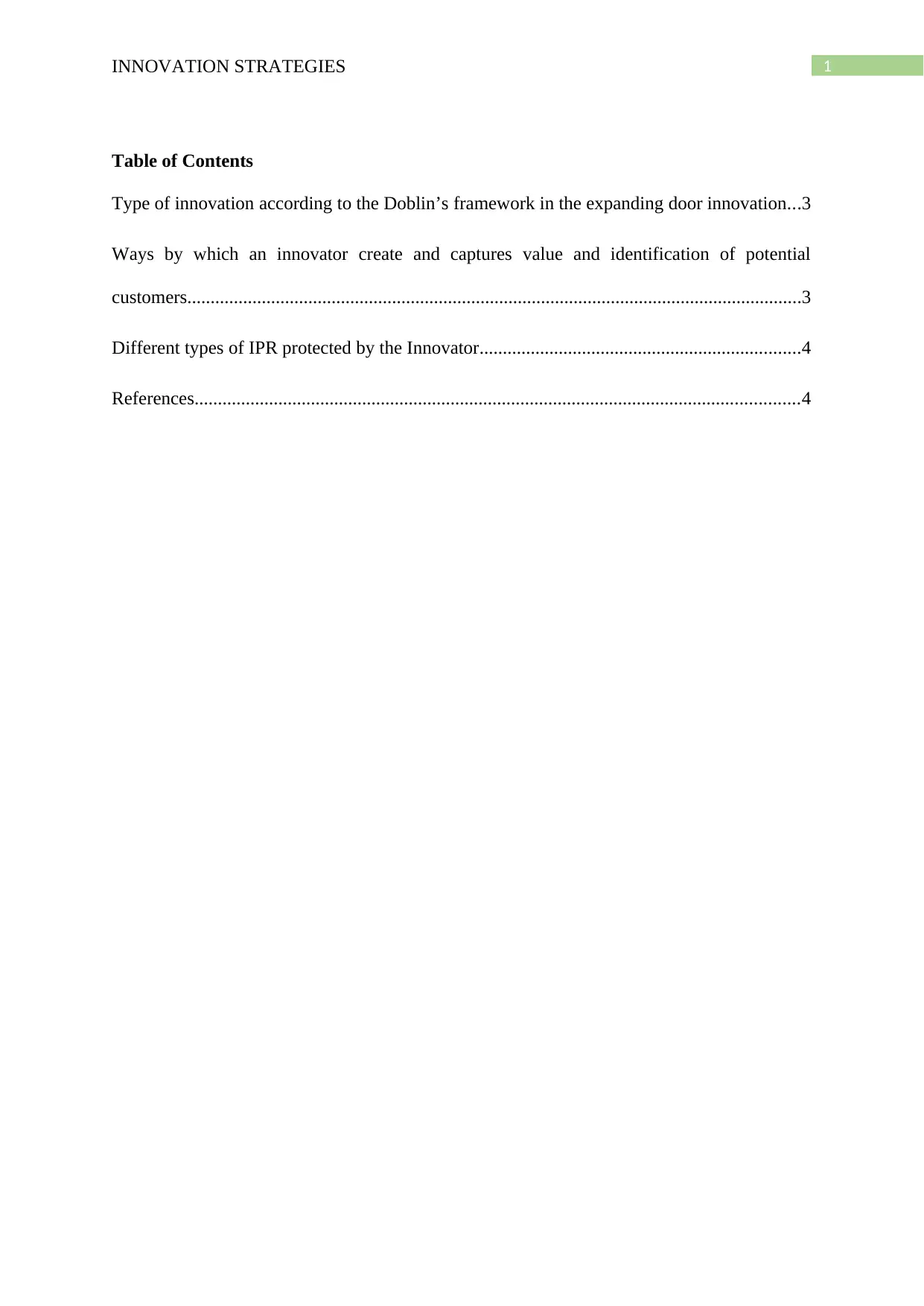
1INNOVATION STRATEGIES
Table of Contents
Type of innovation according to the Doblin’s framework in the expanding door innovation...3
Ways by which an innovator create and captures value and identification of potential
customers....................................................................................................................................3
Different types of IPR protected by the Innovator.....................................................................4
References..................................................................................................................................4
Table of Contents
Type of innovation according to the Doblin’s framework in the expanding door innovation...3
Ways by which an innovator create and captures value and identification of potential
customers....................................................................................................................................3
Different types of IPR protected by the Innovator.....................................................................4
References..................................................................................................................................4
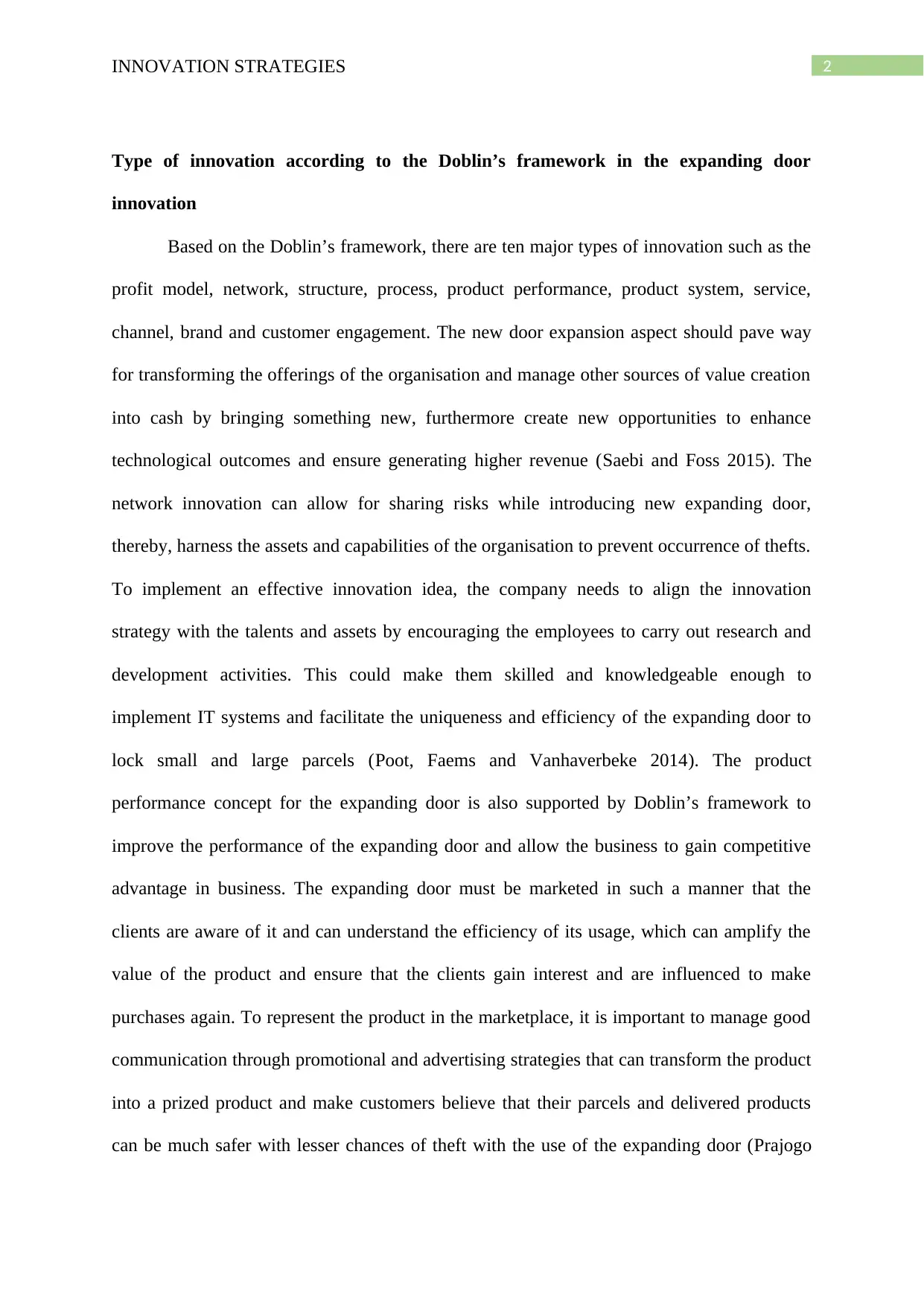
2INNOVATION STRATEGIES
Type of innovation according to the Doblin’s framework in the expanding door
innovation
Based on the Doblin’s framework, there are ten major types of innovation such as the
profit model, network, structure, process, product performance, product system, service,
channel, brand and customer engagement. The new door expansion aspect should pave way
for transforming the offerings of the organisation and manage other sources of value creation
into cash by bringing something new, furthermore create new opportunities to enhance
technological outcomes and ensure generating higher revenue (Saebi and Foss 2015). The
network innovation can allow for sharing risks while introducing new expanding door,
thereby, harness the assets and capabilities of the organisation to prevent occurrence of thefts.
To implement an effective innovation idea, the company needs to align the innovation
strategy with the talents and assets by encouraging the employees to carry out research and
development activities. This could make them skilled and knowledgeable enough to
implement IT systems and facilitate the uniqueness and efficiency of the expanding door to
lock small and large parcels (Poot, Faems and Vanhaverbeke 2014). The product
performance concept for the expanding door is also supported by Doblin’s framework to
improve the performance of the expanding door and allow the business to gain competitive
advantage in business. The expanding door must be marketed in such a manner that the
clients are aware of it and can understand the efficiency of its usage, which can amplify the
value of the product and ensure that the clients gain interest and are influenced to make
purchases again. To represent the product in the marketplace, it is important to manage good
communication through promotional and advertising strategies that can transform the product
into a prized product and make customers believe that their parcels and delivered products
can be much safer with lesser chances of theft with the use of the expanding door (Prajogo
Type of innovation according to the Doblin’s framework in the expanding door
innovation
Based on the Doblin’s framework, there are ten major types of innovation such as the
profit model, network, structure, process, product performance, product system, service,
channel, brand and customer engagement. The new door expansion aspect should pave way
for transforming the offerings of the organisation and manage other sources of value creation
into cash by bringing something new, furthermore create new opportunities to enhance
technological outcomes and ensure generating higher revenue (Saebi and Foss 2015). The
network innovation can allow for sharing risks while introducing new expanding door,
thereby, harness the assets and capabilities of the organisation to prevent occurrence of thefts.
To implement an effective innovation idea, the company needs to align the innovation
strategy with the talents and assets by encouraging the employees to carry out research and
development activities. This could make them skilled and knowledgeable enough to
implement IT systems and facilitate the uniqueness and efficiency of the expanding door to
lock small and large parcels (Poot, Faems and Vanhaverbeke 2014). The product
performance concept for the expanding door is also supported by Doblin’s framework to
improve the performance of the expanding door and allow the business to gain competitive
advantage in business. The expanding door must be marketed in such a manner that the
clients are aware of it and can understand the efficiency of its usage, which can amplify the
value of the product and ensure that the clients gain interest and are influenced to make
purchases again. To represent the product in the marketplace, it is important to manage good
communication through promotional and advertising strategies that can transform the product
into a prized product and make customers believe that their parcels and delivered products
can be much safer with lesser chances of theft with the use of the expanding door (Prajogo
⊘ This is a preview!⊘
Do you want full access?
Subscribe today to unlock all pages.

Trusted by 1+ million students worldwide
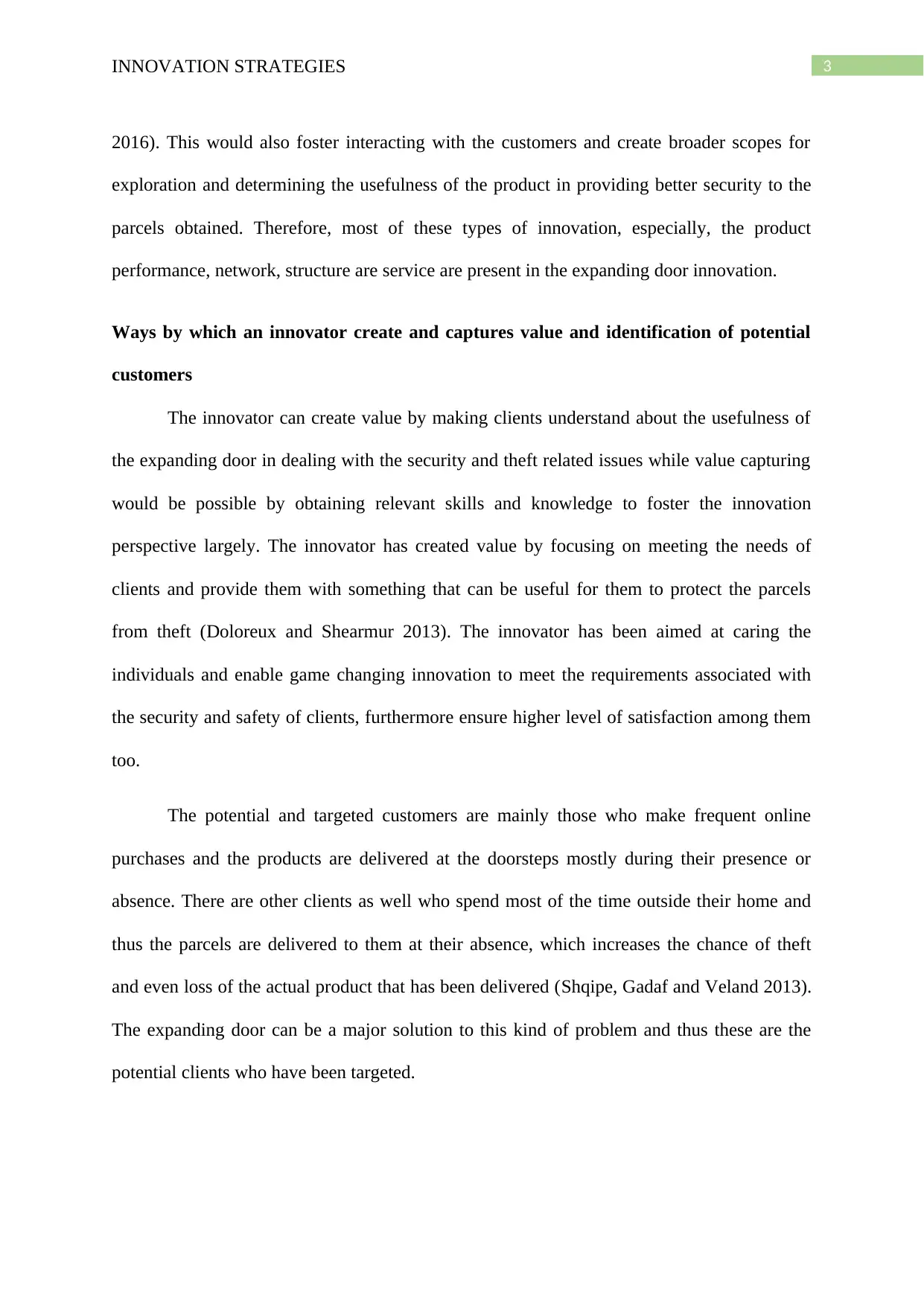
3INNOVATION STRATEGIES
2016). This would also foster interacting with the customers and create broader scopes for
exploration and determining the usefulness of the product in providing better security to the
parcels obtained. Therefore, most of these types of innovation, especially, the product
performance, network, structure are service are present in the expanding door innovation.
Ways by which an innovator create and captures value and identification of potential
customers
The innovator can create value by making clients understand about the usefulness of
the expanding door in dealing with the security and theft related issues while value capturing
would be possible by obtaining relevant skills and knowledge to foster the innovation
perspective largely. The innovator has created value by focusing on meeting the needs of
clients and provide them with something that can be useful for them to protect the parcels
from theft (Doloreux and Shearmur 2013). The innovator has been aimed at caring the
individuals and enable game changing innovation to meet the requirements associated with
the security and safety of clients, furthermore ensure higher level of satisfaction among them
too.
The potential and targeted customers are mainly those who make frequent online
purchases and the products are delivered at the doorsteps mostly during their presence or
absence. There are other clients as well who spend most of the time outside their home and
thus the parcels are delivered to them at their absence, which increases the chance of theft
and even loss of the actual product that has been delivered (Shqipe, Gadaf and Veland 2013).
The expanding door can be a major solution to this kind of problem and thus these are the
potential clients who have been targeted.
2016). This would also foster interacting with the customers and create broader scopes for
exploration and determining the usefulness of the product in providing better security to the
parcels obtained. Therefore, most of these types of innovation, especially, the product
performance, network, structure are service are present in the expanding door innovation.
Ways by which an innovator create and captures value and identification of potential
customers
The innovator can create value by making clients understand about the usefulness of
the expanding door in dealing with the security and theft related issues while value capturing
would be possible by obtaining relevant skills and knowledge to foster the innovation
perspective largely. The innovator has created value by focusing on meeting the needs of
clients and provide them with something that can be useful for them to protect the parcels
from theft (Doloreux and Shearmur 2013). The innovator has been aimed at caring the
individuals and enable game changing innovation to meet the requirements associated with
the security and safety of clients, furthermore ensure higher level of satisfaction among them
too.
The potential and targeted customers are mainly those who make frequent online
purchases and the products are delivered at the doorsteps mostly during their presence or
absence. There are other clients as well who spend most of the time outside their home and
thus the parcels are delivered to them at their absence, which increases the chance of theft
and even loss of the actual product that has been delivered (Shqipe, Gadaf and Veland 2013).
The expanding door can be a major solution to this kind of problem and thus these are the
potential clients who have been targeted.
Paraphrase This Document
Need a fresh take? Get an instant paraphrase of this document with our AI Paraphraser
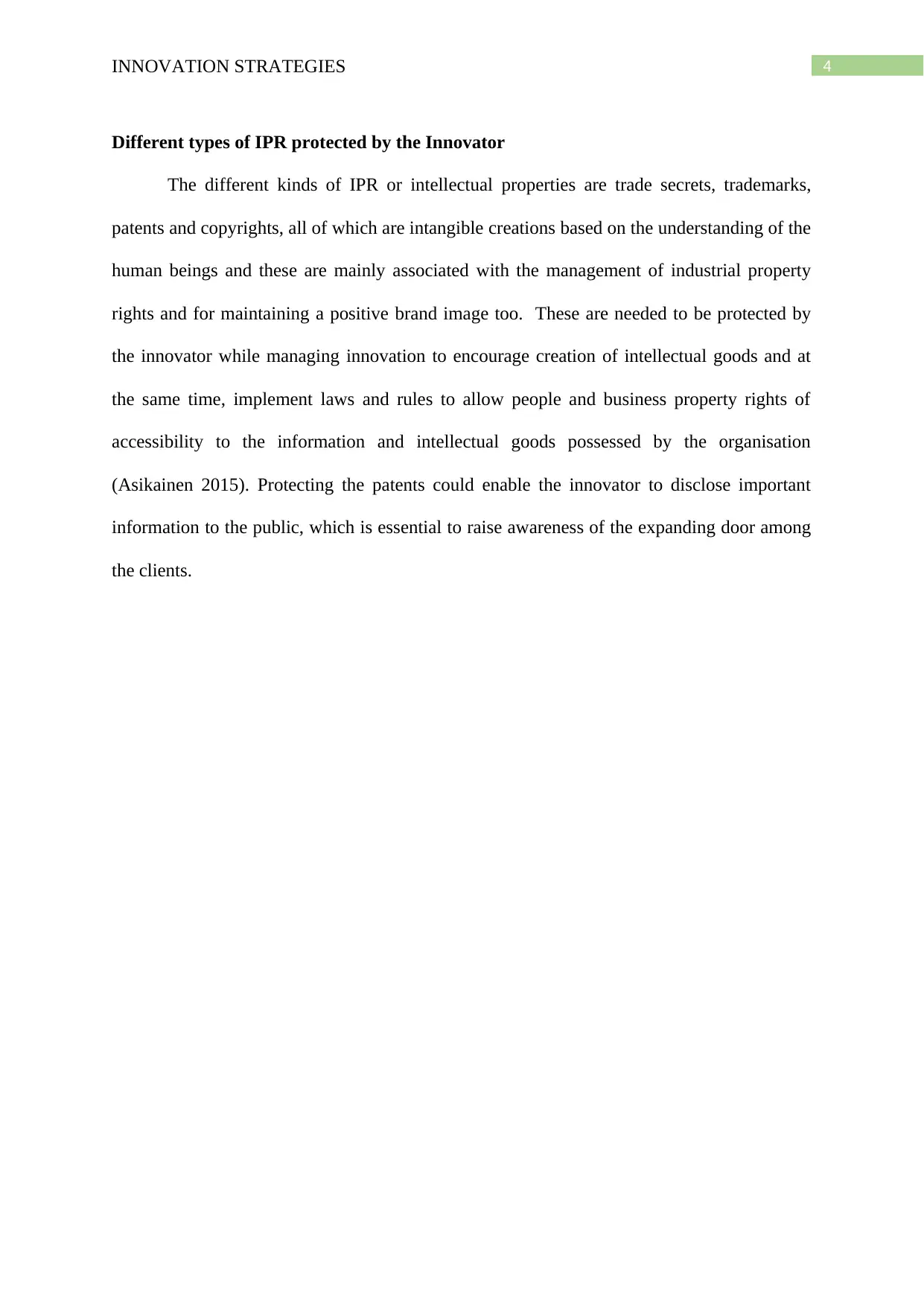
4INNOVATION STRATEGIES
Different types of IPR protected by the Innovator
The different kinds of IPR or intellectual properties are trade secrets, trademarks,
patents and copyrights, all of which are intangible creations based on the understanding of the
human beings and these are mainly associated with the management of industrial property
rights and for maintaining a positive brand image too. These are needed to be protected by
the innovator while managing innovation to encourage creation of intellectual goods and at
the same time, implement laws and rules to allow people and business property rights of
accessibility to the information and intellectual goods possessed by the organisation
(Asikainen 2015). Protecting the patents could enable the innovator to disclose important
information to the public, which is essential to raise awareness of the expanding door among
the clients.
Different types of IPR protected by the Innovator
The different kinds of IPR or intellectual properties are trade secrets, trademarks,
patents and copyrights, all of which are intangible creations based on the understanding of the
human beings and these are mainly associated with the management of industrial property
rights and for maintaining a positive brand image too. These are needed to be protected by
the innovator while managing innovation to encourage creation of intellectual goods and at
the same time, implement laws and rules to allow people and business property rights of
accessibility to the information and intellectual goods possessed by the organisation
(Asikainen 2015). Protecting the patents could enable the innovator to disclose important
information to the public, which is essential to raise awareness of the expanding door among
the clients.
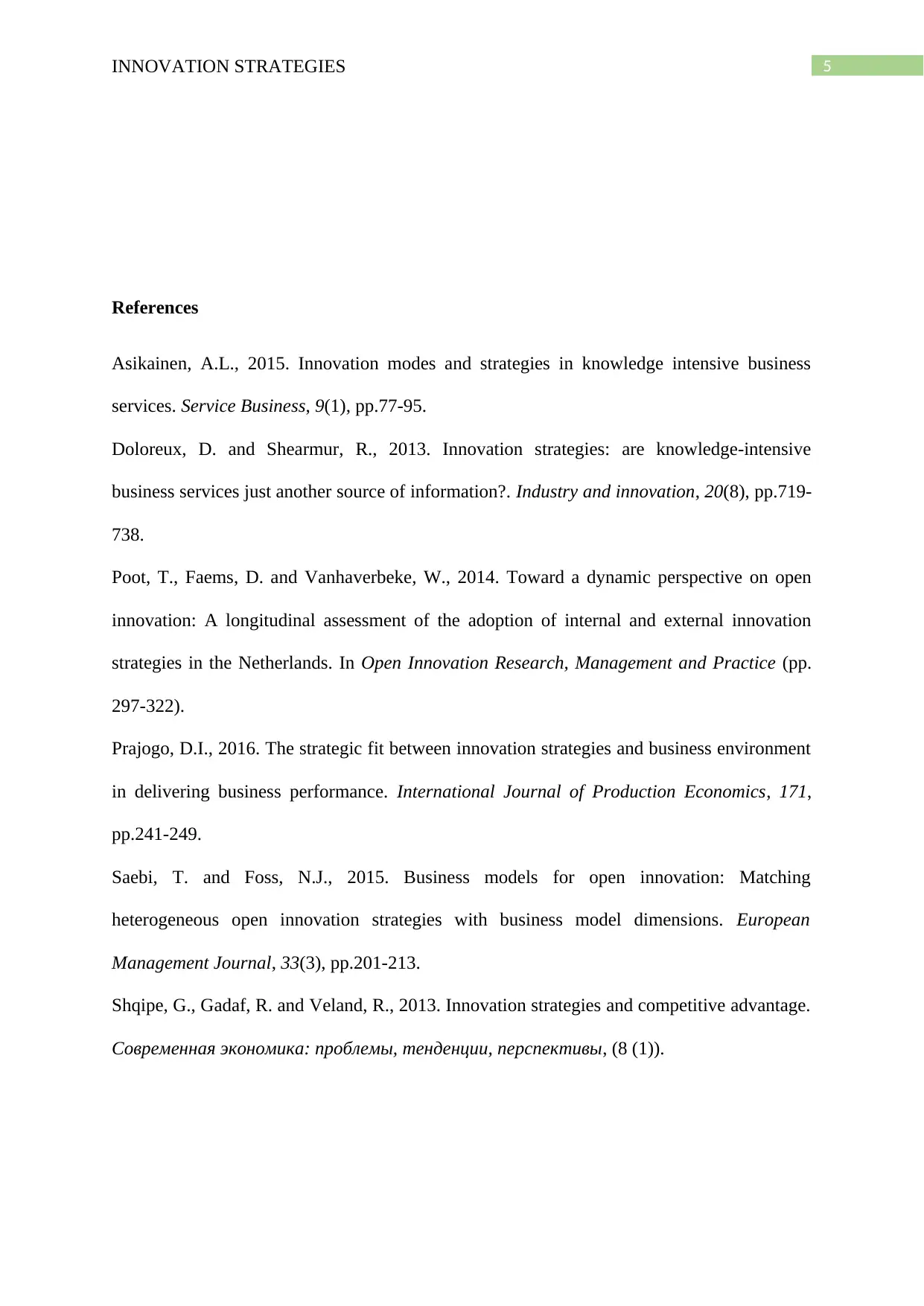
5INNOVATION STRATEGIES
References
Asikainen, A.L., 2015. Innovation modes and strategies in knowledge intensive business
services. Service Business, 9(1), pp.77-95.
Doloreux, D. and Shearmur, R., 2013. Innovation strategies: are knowledge-intensive
business services just another source of information?. Industry and innovation, 20(8), pp.719-
738.
Poot, T., Faems, D. and Vanhaverbeke, W., 2014. Toward a dynamic perspective on open
innovation: A longitudinal assessment of the adoption of internal and external innovation
strategies in the Netherlands. In Open Innovation Research, Management and Practice (pp.
297-322).
Prajogo, D.I., 2016. The strategic fit between innovation strategies and business environment
in delivering business performance. International Journal of Production Economics, 171,
pp.241-249.
Saebi, T. and Foss, N.J., 2015. Business models for open innovation: Matching
heterogeneous open innovation strategies with business model dimensions. European
Management Journal, 33(3), pp.201-213.
Shqipe, G., Gadaf, R. and Veland, R., 2013. Innovation strategies and competitive advantage.
Современная экономика: проблемы, тенденции, перспективы, (8 (1)).
References
Asikainen, A.L., 2015. Innovation modes and strategies in knowledge intensive business
services. Service Business, 9(1), pp.77-95.
Doloreux, D. and Shearmur, R., 2013. Innovation strategies: are knowledge-intensive
business services just another source of information?. Industry and innovation, 20(8), pp.719-
738.
Poot, T., Faems, D. and Vanhaverbeke, W., 2014. Toward a dynamic perspective on open
innovation: A longitudinal assessment of the adoption of internal and external innovation
strategies in the Netherlands. In Open Innovation Research, Management and Practice (pp.
297-322).
Prajogo, D.I., 2016. The strategic fit between innovation strategies and business environment
in delivering business performance. International Journal of Production Economics, 171,
pp.241-249.
Saebi, T. and Foss, N.J., 2015. Business models for open innovation: Matching
heterogeneous open innovation strategies with business model dimensions. European
Management Journal, 33(3), pp.201-213.
Shqipe, G., Gadaf, R. and Veland, R., 2013. Innovation strategies and competitive advantage.
Современная экономика: проблемы, тенденции, перспективы, (8 (1)).
⊘ This is a preview!⊘
Do you want full access?
Subscribe today to unlock all pages.

Trusted by 1+ million students worldwide
1 out of 6
Related Documents
Your All-in-One AI-Powered Toolkit for Academic Success.
+13062052269
info@desklib.com
Available 24*7 on WhatsApp / Email
![[object Object]](/_next/static/media/star-bottom.7253800d.svg)
Unlock your academic potential
Copyright © 2020–2025 A2Z Services. All Rights Reserved. Developed and managed by ZUCOL.





